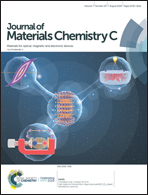Evidence for the dynamic relaxation behavior of oxygen vacancies in Aurivillius Bi2MoO6 from dielectric spectroscopy during resistance switching†
Abstract
The oxygen anion or, equivalently, the oxygen vacancy transport process is a key issue in valence change memory. Herein, based on the Aurivillius phase oxygen ion conductor Bi2MoO6, resistive random access memory devices with a Pt/Bi2MoO6/fluorine-doped SnO2 structure show bipolar resistive switching behavior with high stability, excellent data retention, and potential for multilevel data storage. In addition, dielectric spectroscopy is employed to probe the characteristics of both high resistance and low resistance states to confirm oxygen ion migration and understand the dynamics of oxygen vacancies. A very large change of nearly three orders of magnitude in loss tangent is found. It has been confirmed that one relaxation peak in the LRS originates from the oriented polarization of oxygen vacancies. The activation energy for oxygen vacancy migration of 0.21 eV and the relaxation time of 6.9 × 10−8 s are further deduced. In combination with first-principles calculations, a mechanism involving the formation and rupture of conductive filaments formed by oxygen vacancies is proposed to explain the resistive switching behavior. This work provides meaningful insights for identifying the exact mobile species in resistive switching and understanding its dynamic relaxation mechanism.



 Please wait while we load your content...
Please wait while we load your content...